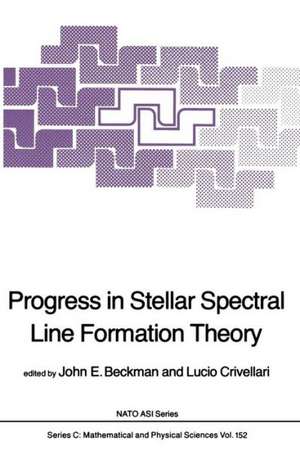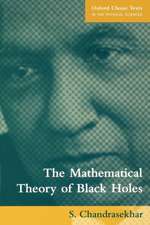Progress in Stellar Spectral Line Formation Theory: Nato Science Series C:, cartea 152
Editat de J.E. Beckman, L. Crivellarien Limba Engleză Paperback – 10 noi 2011
Din seria Nato Science Series C:
- 24%
 Preț: 797.66 lei
Preț: 797.66 lei - 18%
 Preț: 957.62 lei
Preț: 957.62 lei - 18%
 Preț: 957.13 lei
Preț: 957.13 lei - 18%
 Preț: 1227.52 lei
Preț: 1227.52 lei -
 Preț: 396.40 lei
Preț: 396.40 lei -
 Preț: 403.75 lei
Preț: 403.75 lei - 18%
 Preț: 1239.37 lei
Preț: 1239.37 lei - 18%
 Preț: 1236.51 lei
Preț: 1236.51 lei - 18%
 Preț: 1231.78 lei
Preț: 1231.78 lei - 18%
 Preț: 1229.10 lei
Preț: 1229.10 lei - 18%
 Preț: 1835.21 lei
Preț: 1835.21 lei - 24%
 Preț: 1076.36 lei
Preț: 1076.36 lei -
 Preț: 390.46 lei
Preț: 390.46 lei -
 Preț: 369.63 lei
Preț: 369.63 lei - 18%
 Preț: 1232.41 lei
Preț: 1232.41 lei -
 Preț: 394.51 lei
Preț: 394.51 lei - 18%
 Preț: 1226.24 lei
Preț: 1226.24 lei - 18%
 Preț: 1845.80 lei
Preț: 1845.80 lei -
 Preț: 399.88 lei
Preț: 399.88 lei -
 Preț: 384.28 lei
Preț: 384.28 lei -
 Preț: 390.88 lei
Preț: 390.88 lei -
 Preț: 381.19 lei
Preț: 381.19 lei - 18%
 Preț: 1848.64 lei
Preț: 1848.64 lei - 18%
 Preț: 951.14 lei
Preț: 951.14 lei - 18%
 Preț: 1230.35 lei
Preț: 1230.35 lei - 18%
 Preț: 1236.51 lei
Preț: 1236.51 lei -
 Preț: 401.03 lei
Preț: 401.03 lei -
 Preț: 406.25 lei
Preț: 406.25 lei - 18%
 Preț: 1230.84 lei
Preț: 1230.84 lei -
 Preț: 418.34 lei
Preț: 418.34 lei - 18%
 Preț: 1223.74 lei
Preț: 1223.74 lei
Preț: 397.97 lei
Nou
Puncte Express: 597
Preț estimativ în valută:
76.16€ • 78.68$ • 63.39£
76.16€ • 78.68$ • 63.39£
Carte tipărită la comandă
Livrare economică 25 martie-08 aprilie
Preluare comenzi: 021 569.72.76
Specificații
ISBN-13: 9789401088701
ISBN-10: 9401088705
Pagini: 468
Ilustrații: 464 p.
Dimensiuni: 155 x 235 x 25 mm
Greutate: 0.65 kg
Ediția:Softcover reprint of the original 1st ed. 1985
Editura: SPRINGER NETHERLANDS
Colecția Springer
Seria Nato Science Series C:
Locul publicării:Dordrecht, Netherlands
ISBN-10: 9401088705
Pagini: 468
Ilustrații: 464 p.
Dimensiuni: 155 x 235 x 25 mm
Greutate: 0.65 kg
Ediția:Softcover reprint of the original 1st ed. 1985
Editura: SPRINGER NETHERLANDS
Colecția Springer
Seria Nato Science Series C:
Locul publicării:Dordrecht, Netherlands
Public țintă
ResearchCuprins
I. Frequency redistribution problems in line formationtheory.- Observed and computed stellar line profiles: the roles played by partial redistribution, geometrical extent and expansion.- General aspects of partial redistribution and its astrophysical importance.- Kinetic aspects of redistribution in spectral lines.- Non local effects on the redistribution of resonant scattered photons.- Asymptotic properties of complete and partial frequency redistribution.- Some comments upon the line emission profile ??.- A modified Rybicki method with partial redistribution.- Redistribution functions: a review of computational methods.- The effect of abundance values on partial redistribution line computations.- Partial redistribution interlocking in the solar chromosphere.- Pannel discussion on partial redistribution.- II. Methods in line radiative transfer.- Numerical methods in radiative transfer.- Partial versus complete linearization.- Radiative transfer diagnostics: understanding multi-level transfer calculations.- A new method for solving multi-level non-LTE problems.- Escape probability methods.- Numerically stable discrete ordinate solutions of the radiative transfer equation.- NLTE spectral line formation in a three-dimensional atmosphere with velocity fields.- A code for line blanketing without local thermodynamic equilibrium.- Pannel discussion on radiative transfer methods.- III. Observational and theoretical aspects of spectral line formation in astrophysical and laborator environments.- a) Laboratory environment.- Line formation in laboratory plasmas.- b) Stellar environment.- Observational problems in spectral line formation.- Current problems of line formation in early-type stars.- Stellar surface inhomogeneities and the interpretation of stellar spectra.- Thetheory of line transfer in expanding atmospheres.- Computed HeII spectra for Wolf-Rayet stars.- Partial redistribution in the wind of red giants.- Modeling lines formed in the expanding chromospheres of red giants.- Transfer of Lyman-? radiation in solar coronal loops.- Pressure broadening and solar limb effect.- Hydrogen line formation in dense plasmas in the presence of a magnetic field.- c) Non-stellar environment.- A review of line formation in molecular clouds.- List of computer codes available at present.- Index of Subjects.













